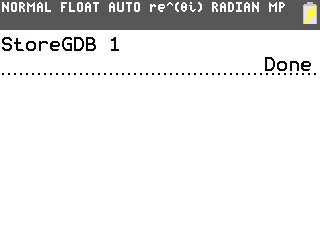Solution 34617: Storing and Recalling the Graph Elements on the TI-84 Plus C Silver Edition Graphing Calculator.
How can I store all the graphing elements on a TI-84 Plus C Silver Edition graphing calculator?
All of the elements that define a particular graph can be stored to a graph database (GDB) on the calculator, allowing the user to recreate the graph at a later time. A GDB is different than a picture in that a GDB stores the elements that make up the resulting graph, instead of simply the output. The following elements are contained in a GDB:
1) Graphing mode
2) Window variables
3) Format settings
4) All functions in the Y= editor and the selection status of each
5) Graph style for each Y= function
You can have up to 10 GDB's stored in the calculator's memory at any given time.
Please Note: GDB's do not contain drawn items or stat plot definitions.
For more information on using pictures, please see the case entitled Opening Picture Files on a TI-83 Family, TI-84 Plus Family, or TI-Nspire™ Handheld in TI-84 Plus Mode..
Storing a graph database:
1) Press [2nd] [DRAW] then press the right arrow key twice to select the DRAW STO menu
2) Press [3] to select 3:StoreGDB
3) Input the number (0-9) of the GDB variable to which you want to store the graph database.
Please Note: You can also select a variable from the GDB secondary menu by pressing [VARS] [3] 3) Press [ENTER] to store the current database to the specified GDB variable

Recalling a graph database:
CAUTION: When you recall a GDB, it replaces all existing Y= functions. Consider storing the current Y= functions to another database before recalling a GDB.
1) Press [2nd] [DRAW] then press the right arrow key twice to select the DRAW STO menu
2) Press [4] to select 4:RecallGDB
3) Input the number (0-9) of the GDB variable from which you want to recall a graph database
Please Note: You can also select a variable from the GDB secondary menu by pressing [VARS] [3] 4) Press [ENTER] to replace the current database with the recalled GDB

For additional information on graph databases and other features, refer to the TI-84 Plus C Silver Edition guidebook.
